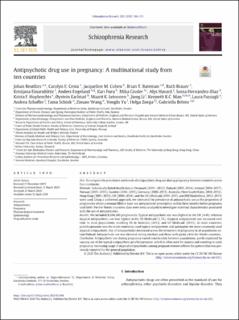| dc.contributor.author | Reutfors, Johan | |
| dc.contributor.author | Cesta, Carolyn | |
| dc.contributor.author | Cohen, Jacqueline Mallory | |
| dc.contributor.author | Bateman, Brian T | |
| dc.contributor.author | Brauer, Ruth | |
| dc.contributor.author | Einarsdottir, Kristjana | |
| dc.contributor.author | Engeland, Anders | |
| dc.contributor.author | Furu, Kari | |
| dc.contributor.author | Gissler, Mika | |
| dc.contributor.author | Havard, Alys | |
| dc.contributor.author | Hernandez-Diaz, Sonia | |
| dc.contributor.author | Huybrechts, Krista F. | |
| dc.contributor.author | Karlstad, Øystein | |
| dc.contributor.author | Leinonen, Maarit | |
| dc.contributor.author | Li, Jiong | |
| dc.contributor.author | Man, Kenneth K. C. | |
| dc.contributor.author | Pazzagli, Laura | |
| dc.contributor.author | Schaffer, Andrea | |
| dc.contributor.author | Schink, Tania | |
| dc.contributor.author | Wang, Zixuan | |
| dc.contributor.author | Yu, Yongfu | |
| dc.contributor.author | Zoega, Helga | |
| dc.contributor.author | Bröms, Gabriella | |
| dc.date.accessioned | 2021-04-23T13:05:20Z | |
| dc.date.available | 2021-04-23T13:05:20Z | |
| dc.date.created | 2020-09-22T13:42:05Z | |
| dc.date.issued | 2020 | |
| dc.Published | Schizophrenia Research. 2020, 220 (June), 106-115. | |
| dc.identifier.issn | 0920-9964 | |
| dc.identifier.uri | https://hdl.handle.net/11250/2739380 | |
| dc.description.abstract | Aim
To compare the prevalence and trends of antipsychotic drug use during pregnancy between countries across four continents.
Methods
Individually linked health data in Denmark (2000−2012), Finland (2005–2014), Iceland (2004–2017), Norway (2005–2015), Sweden (2006–2015), Germany (2006–2015), Australia (New South Wales, 2004–2012), Hong Kong (2001–2015), UK (2006–2016), and the US (Medicaid, 2000–2013, and IBM MarketScan, 2012–2015) were used. Using a uniformed approach, we estimated the prevalence of antipsychotic use as the proportion of pregnancies where a woman filled at least one antipsychotic prescription within three months before pregnancy until birth. For the Nordic countries, data were meta-analyzed to investigate maternal characteristics associated with the use of antipsychotics.
Results
We included 8,394,343 pregnancies. Typical antipsychotic use was highest in the UK (4.4%) whereas atypical antipsychotic use was highest in the US Medicaid (1.5%). Atypical antipsychotic use increased over time in most populations, reaching 2% in Australia (2012) and US Medicaid (2013). In most countries, prochlorperazine was the most commonly used typical antipsychotic and quetiapine the most commonly used atypical antipsychotic. Use of antipsychotics decreased across the trimesters of pregnancy in all populations except Finland. Antipsychotic use was elevated among smokers and those with parity ≥4 in the Nordic countries.
Conclusion
Antipsychotic use during pregnancy varied considerably between populations, partly explained by varying use of the typical antipsychotic prochlorperazine, which is often used for nausea and vomiting in early pregnancy. Increasing usage of atypical antipsychotics among pregnant women reflects the pattern that was previously reported for the general population. | en_US |
| dc.language.iso | eng | en_US |
| dc.publisher | Elsevier | en_US |
| dc.relation.uri | https://www.sciencedirect.com/science/article/pii/S0920996420301584 | |
| dc.rights | Attribution-NonCommercial-NoDerivatives 4.0 Internasjonal | * |
| dc.rights.uri | http://creativecommons.org/licenses/by-nc-nd/4.0/deed.no | * |
| dc.title | Antipsychotic drug use in pregnancy: A multinational study from ten countries | en_US |
| dc.type | Journal article | en_US |
| dc.type | Peer reviewed | en_US |
| dc.description.version | publishedVersion | en_US |
| dc.rights.holder | Copyright 2020 The Authors | en_US |
| cristin.ispublished | false | |
| cristin.fulltext | postprint | |
| cristin.qualitycode | 2 | |
| dc.identifier.doi | 10.1016/j.schres.2020.03.048 | |
| dc.identifier.cristin | 1832124 | |
| dc.source.journal | Schizophrenia Research | en_US |
| dc.source.40 | 220 | |
| dc.source.14 | June | |
| dc.source.pagenumber | 106-115 | en_US |
| dc.identifier.citation | Schizophrenia Research. 2020, 220: 106-115 | en_US |
| dc.source.volume | 220 | en_US |

